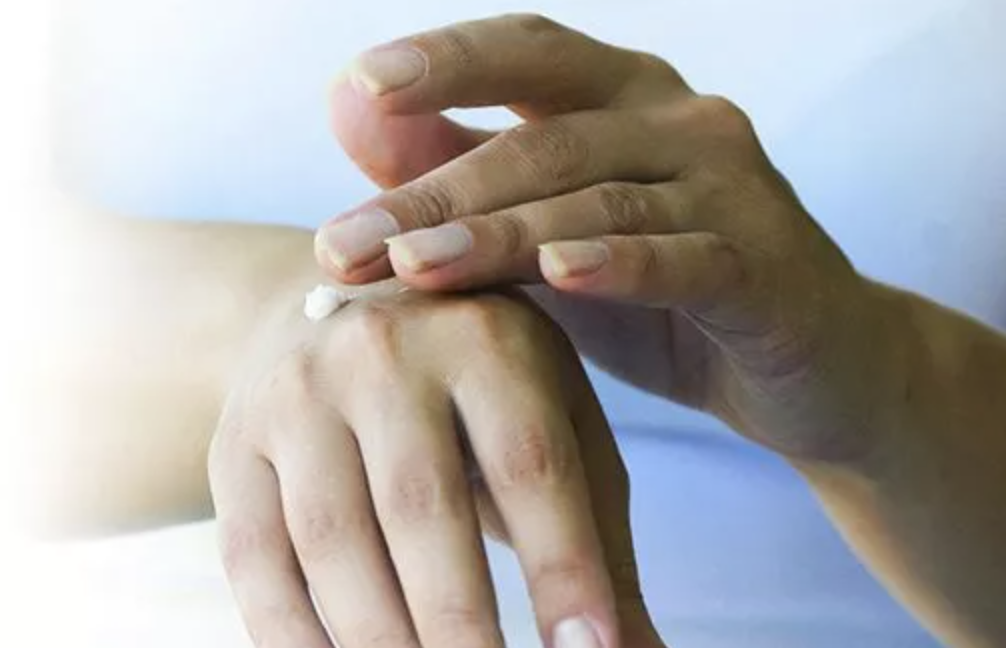Do moisturizers help eczema?
Moisturizers are the first-line therapy in treating eczema. They help protect the outer layer of the skin by sealing in moisture, combating dryness, keeping out allergens, irritants and bacteria and preventing flare-ups. And they soothe the skin for long-lasting hydration.
Doctors recommend you apply a moisturizer at least twice per day, including once after a bath or shower. Develop a schedule so that moisturizing becomes part of your skincare routine.
If you experience symptoms on your hands, keep moisturizer by all sinks in the home or carry a small tube with you. This way you can easily moisturize every time you wash your hands throughout the day.
What types of moisturizers are used to treat eczema?
When considering a moisturizer, the first thing to look for is how much oil it contains. The more oil in a moisturizer, the better it is for treating eczema. If your skin feels greasy or sticky after applying a moisturizer, that means the product likely contains plenty of oil.
Look for products that do not contain added ingredients – such as fragrances, dyes or alcohols – that can irritate the skin.
Ointments
Ointments typically contain the most oil and are effective at sealing in moisture. Mineral oil and petroleum jelly are recommended, as is coconut oil as long as you or your child are not allergic to coconut.
Creams
Creams contain less oil than ointments. If you don’t like the greasy or sticky feeling from using ointments, then consider using a cream.
Lotions
Lotions contain more water than oil. As a result, these do not seal in the moisture as well as ointments and creams. Lotions also are more likely to contain fragrances, preservatives and other ingredients that can harm sensitive skin.
What do the ingredients in moisturizers do for eczema?
- Humectants (ceramides, glycerin, sorbitol) helps draw in moisture
- Petroleum jelly, mineral oil, coconut oil, silicone and/or lanolin helps seal in moisture
- Emollients (linoleic and lauric acids) help smooth the skin.
How do I apply moisturizer to treat eczema?
- Soften the moisturizer by rubbing it between your hands.
- Apply it to affected areas using your palm, in a downward stroke.
- Use a thick layer; the skin will absorb any excess moisturizer within a minute.
Are baths a good treatment for eczema?
Eczema is more than just dry skin. Flares erupt unpredictably: dry, scaly, irritated spots on the face or hands, or inside the crease of the elbow or knee. The itch is almost unbearable – and scratching makes it worse, resulting in what feels like an endless cycle.
Eczema has no cure, so preventing and managing flare-ups becomes a priority. The trick is figuring out how to get moisture back into the skin and keep it there. Slathering on moisturizer by itself usually won’t do it; neither will simply soaking in a bath.
In fact, some people think bathing dries out the skin and makes it worse. We all know how frequent hand-washing dries out the hands. The reason for this is not the water itself, however, but the soaps we use and the fact that we often just wash and dry – forgetting to add a moisturizer to seal in the water.
What is the soak and seal method for eczema?
It may be true that bathing too frequently can dry out skin and exacerbate eczema, but rather than skipping baths, doctors recommend shorter ones.
To ease the itch and rehydrate the skin, doctors recommend a “soak and seal” method. Soak the skin to allow water to absorb, then use a moisturizer immediately to seal in the wetness.
Soak
Soak your skin in lukewarm water (not hot water), either a bath or a shower, for 10-15 minutes. Skip the soap or bubble bath: stick to clear water. If necessary, use a gentle cleanser free of fragrances and chemicals. For areas like your face that can’t be soaked in a tub, apply a wet washcloth for at least 5 minutes.
Pat Dry
Gently pat the skin dry with a soft towel – don’t rub, as that will irritate the sensitive areas.
Infographic chart of Topical Treatments and Systemic Treatments for Atopic Dermatitis
Moisturize
Apply moisturizer immediately (within 3 minutes is the rule) to seal the water in. If you have a prescription skin medication, use that first on affected areas. Then use a high-oil-content ointment.
Petroleum jelly may be messy, but it’s often the best solution for eczema flares. In general, use fragrance-free, dye-free or clear ointments. Lotions contain too much water or alcohol and easily evaporate, while some creams have preservatives or fragrances to which you may be sensitive.
Extra Help
Some doctors suggest putting a half-cup of household bleach or a cup of vinegar into the bath water. The theory is that bleach and vinegar may help kill bacteria and prevent infection.
Others suggest adding bath oil, salt, baking soda or oatmeal to help ease persistent itching. Baking soda and oatmeal can also be made into a paste that can be applied to the skin.
Talk with your doctor about whether you should try these specific baths.
© 2021 Allergy and Asthma Network

Last updated : 5/25/2021